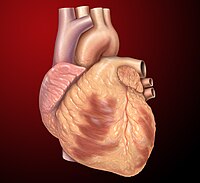
Photo from wikipedia
BACKGROUND The palpation of the apex beat, one of the most fundamental physical examinations, provides a clue to left ventricular (LV) dilatation and hypertrophy; however, its relation to left atrial… Click to show full abstract
BACKGROUND The palpation of the apex beat, one of the most fundamental physical examinations, provides a clue to left ventricular (LV) dilatation and hypertrophy; however, its relation to left atrial (LA) volume has rarely been investigated. METHODS The clinical value of the apex beat, especially in relation to LA volume was studied in 138 consecutive patients. Patients were examined in the supine position for a palpable apex beat. When an apex beat was felt, the apex beat distance, defined as the distance from the mid-clavicular line to the lateral border of the apex beat, was measured. The LA and LV geometry were assessed using echocardiography. RESULTS Of the 138 patients, an apex beat was palpable in 52 (38%) patients and the apex distance of these 52 patients ranged from -2 to 8 cm. The parameters of LV dilatation or hypertrophy were significant according to univariate but not to multivariate analysis. Only LA volume index was significant both for the palpability of the apex beat (p=0.0042) and the apex distance (p=0.0017) by multivariate analysis. The best cut-off point for the apex distance was -1 cm for LA enlargement (sensitivity 61%, specificity 92%, p<0.0001). CONCLUSIONS The LA volume is the most significant factor for the palpability and leftward deviation of the apex beat. Palpation of the apex beat is a crucial diagnostic tool for the detection of not only LV dilatation or hypertrophy but also of LA enlargement.
Journal Title: Journal of cardiology
Year Published: 2021
Link to full text (if available)
Share on Social Media: Sign Up to like & get
recommendations!